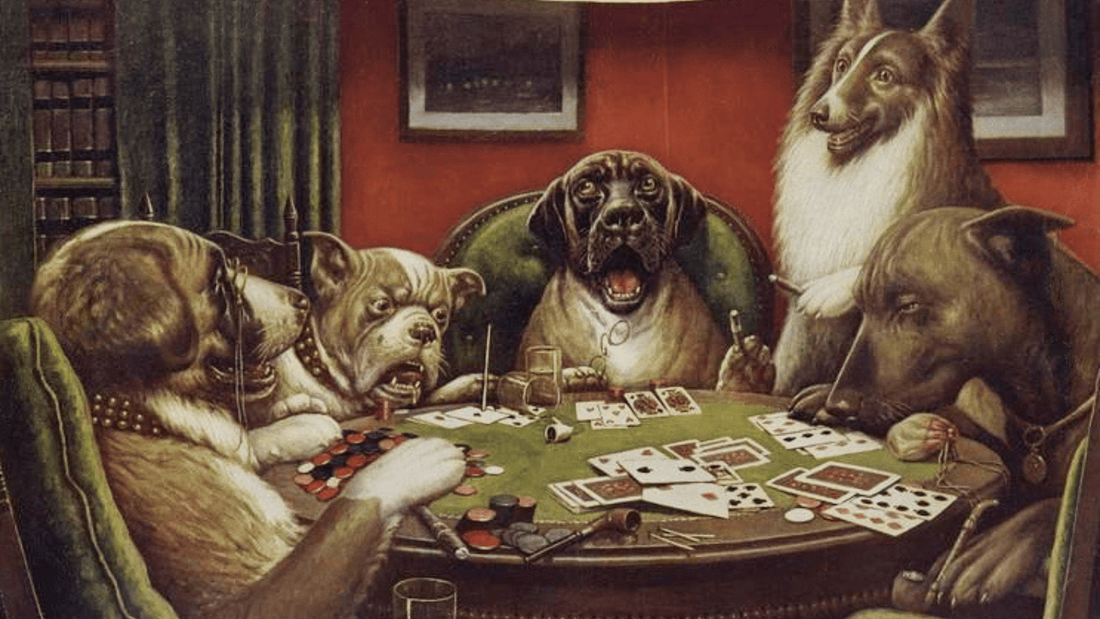
Who Painted Dogs Playing Poker?
When one thinks of the most memorable artworks, a series depicting anthropomorphic dogs may not be the first thing that comes to mind. However, this is precisely what Cassius Marcellus Coolidge’s 16-piece collection of oil paintings called Dogs Playing Poker is. Since its original production started in the late 1890s, the paintings have cemented a legacy that remains relevant to this day.
In fact, the paintings are still often referenced in contemporary pop culture. For instance, just earlier this year, the mega-hit video game Fortnite released a cinematic inspired by the paintings. Released as a means to announce their new skins bundle, the video shows a character with an Agent Meowscles entering a room where four other players with dog heads are caught mid-poker game. Their surprised poses are reminiscent of the poses that Coolidge’s subjects were often depicted in.
But what is the real story of these famous paintings and their connection to poker? And who is the man behind these works?
The broader American poker landscape from Coolidge’s time to today
When Coolidge started his series, poker was already a staple card game across most of America. It’s worth noting that historians believe this period saw many of the most important changes and additions in poker history. For instance, during the last few years of the 1890s, straight and wild cards were introduced. A few years later, into the 1900s, poker varieties such as Texas Hold’em, Stud, and Community Card hit the mainstream.
Today, contemporary poker still retains many features and considerations from Coolidge’s time. Such enduring aspects even extend to digital poker platforms. Case in point, those who want to play online poker in Florida can still enjoy many of the same poker variations mentioned above. On the country’s leading online poker site, Americas Cardroom, players can legally play in games across varieties such as No Limit Hold’em and Stud. This includes games in their massive Venom tournaments, with prize pools of over $10 million. Of course, the same poker varieties are also beloved in physical poker establishments, where many of the same game types continue to draw in countless players. For example, poker rooms in California remain so successful that they make millions every year. So much so, that the city of San Jose even shared that they receive up to $30 million in funding from card rooms yearly. With this in mind, it’s clear that poker's continued significance is part of why Coolidge’s series has retained its popularity through the years.

Credit: Find-a-Grave under public domain.
Dogs Playing Poker: Cassius Marcellus Coolidge’s cheeky masterpiece
Given the above, it’s safe to say that Coolidge chose to portray poker throughout most of the series because it was already a famous card game that was familiar to most people. After all, he was hired to paint the series for public consumption as a way for Brown & Bigelow to advertise cigars.
However, some speculate that he must have also been drawn to poker because of a deeper connection to his name. In poker, players often play for cash–which just so happened to be his nickname. Some of his work has even been signed “Cash” or Kash Koolidge.
This brings us to the artist himself. Born in 1844 in Antwerp, the American artist had little to no formal artistic training. Instead, he honed his talent through real-world experience. At one point, he was even a sign painter. That said, being from the Big Apple may have also helped his creativity. To this day, the art scene in New York remains among the most celebrated in the country. A recent survey by Betway Casino even notes that it’s consistently among the top five destinations for American street art.
While alive, Coolidge didn’t receive much critical acclaim. During one April Fool’s Day, the Chrysler Museum of Art even made a joke saying it was planning to exhibit Dogs Playing Poker. Contrary to what many high-brow art critics said, Coolidge’s work has received a much warmer reception in recent decades. In the 2000s alone, several paintings from the series have sold at auction for thousands of dollars. During one such event in 2015, one work entitled Poker Game was sold for a whopping $658,000. This is proof that while Coolidge may not have been the most acclaimed artist in his time, he was right to bet on the long-term appeal of whimsical creatures and card games.
